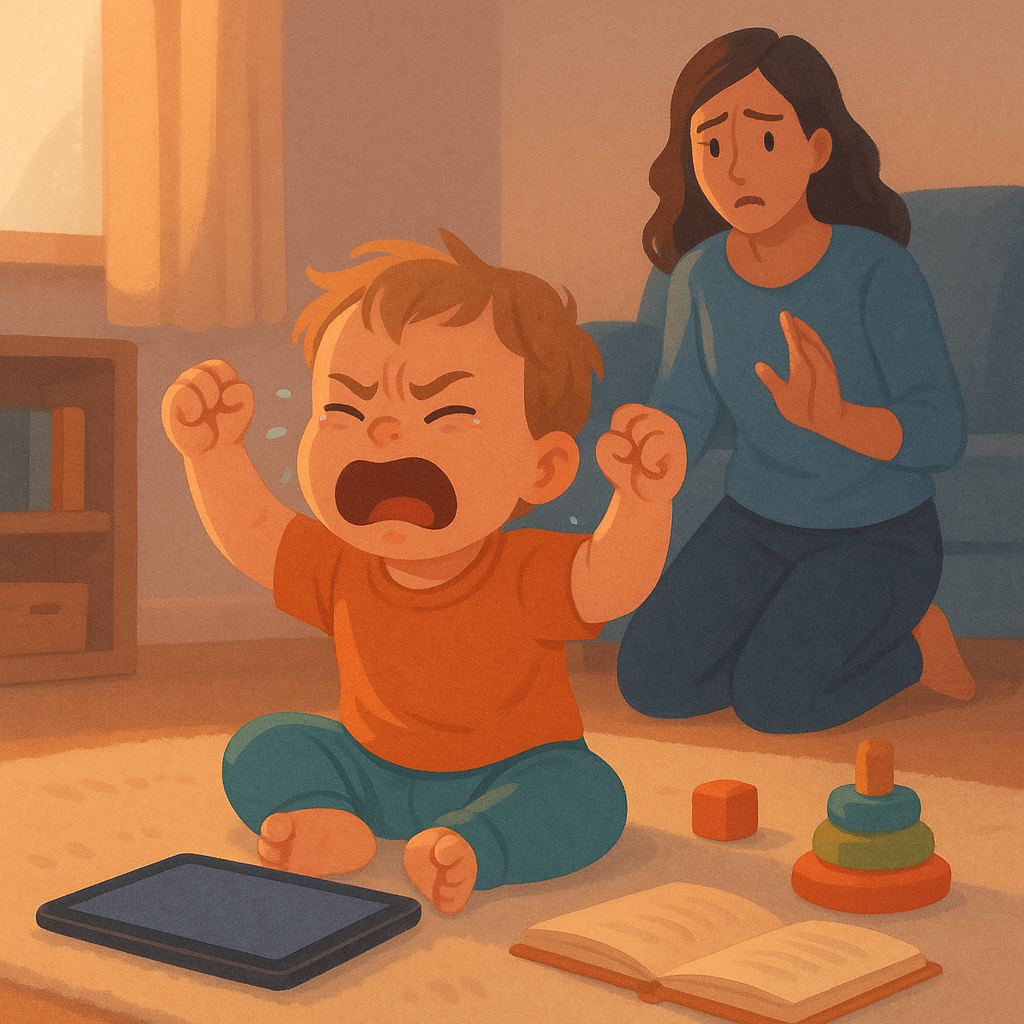
Why Your Toddler Melts Down After iPad Time (And What To Do)
You've been there. Your toddler is happily watching videos on the iPad. Everything is peaceful.
Then you take the iPad away.
Suddenly your sweet child is screaming, crying, throwing things.
You're not failing as a parent. What's actually happening is a neurological response to how screens affect developing brains.
The Brain Chemistry Behind Meltdowns
Tablets trigger the same reward pathways as addictive substances.
Every swipe and tap releases dopamine (your brain's "feel good" chemical). For adults, this is manageable. For toddlers with zero impulse control? It's overwhelming.
Dr. Nicholas Kardaras describes screens as "digital cocaine" for developing brains. Brain scans show screen time activates the same neural pathways as cocaine use.
When you take the iPad away, your toddler experiences a chemical crash. Their brain was flooded with dopamine, now it's suddenly gone.
The meltdown feels intense because they're literally experiencing withdrawal.
Why Toddlers Are Vulnerable
Adult brains have developed prefrontal cortexes that handle impulse control and emotional regulation. Toddler brains don't fully develop this until the mid-20s.
Add the dopamine flood from screens, and you get:
- Intense cravings for "just five more minutes"
- Inability to self-regulate
- Disproportionate emotional responses
- Physical aggression
- Prolonged crying
Brain development is colliding with addictive technology.
Warning Signs of Screen Problems
Immediate meltdowns within seconds of screen removal
Intensity disproportionate to the situation
Physical aggression (hitting, throwing)
Difficulty recovering (lasts longer than usual tantrums)
Constant requests throughout the day
Irritability between screen sessions
"My son would play happily for an hour without screens. But after 15 minutes on the iPad, he was irritable all day," one dad shared.
What Doesn't Work
Reasoning with them: Their prefrontal cortex isn't developed enough during a dopamine crash.
Punishment or time-outs: They're not choosing to melt down. Their brain chemistry is dysregulated.
Immediate replacement activities: Their brain is still in crash mode.
Gradually increasing time: More screen time means deeper dopamine dependence.
Strategy 1: Prevention (Most Effective)
Reduce total screen time gradually. Cut back to under 1 hour daily for ages 2-5.
Eliminate screens before transitions. No iPad within an hour of meals or car rides.
Create screen-free days. One or two days weekly gives the brain a complete reset.
Never use screens as a pacifier. This trains the brain to need them for emotional regulation.
One mother: "We went from 2-3 hours daily to 30 minutes three times a week. Week one was brutal. By week three, meltdowns were 80% reduced. My daughter now plays independently, something she never did before."
Strategy 2: Transition Buffers
5-minute warning plus engagement: Sit with them before time ends. Transition together.
Physical activities immediately after: Jumping jacks, quick walk, dancing. Physical movement helps regulate the chemical crash.
Tactile shift: Have hands-on activity ready. Playdough, water play, or tracing work well.
The Smart Sketch Workbook works as a transition because grooved tracing provides tactile feedback that shifts attention from screen to hands-on activity.
"After iPad time, we do 5 minutes of Smart Sketch tracing. The tactile nature helps her shift gears. It's like a palate cleanser for her brain," one parent shared.
Strategy 3: During Meltdowns
Physical presence without pressure: Sit nearby. Your calm presence helps regulate their nervous system.
Simple acknowledgment: "You're upset iPad time is over. I understand." Don't explain or lecture.
Offer comfort if wanted: Some kids need hugs. Others need space.
Wait it out: Dopamine-crash meltdowns must run their course.
Don't give in: Giving the iPad back teaches that intense meltdowns get rewarded.
Replacing the Dopamine Source
Your toddler's brain needs dopamine. Replace artificial sources with natural ones:
Physical play (running, jumping)
Creative activities (drawing, building)
Accomplishment activities (puzzles, tracing)
Social connection (playing with others)
Novel experiences (new parks, activities)
What One Month Looks Like
Week 1: Brutal. Increased meltdowns, constant iPad requests.
Week 2: Slight improvement. Longer independent play.
Week 3: Real change. More creative play, fewer meltdowns.
Week 4: New normal. Requests drop dramatically.
"Week one, I cried. By week four, my son was playing creatively for 45 minutes at a time. Completely worth it," one mother shared.
Starting Today
This week:
- Track current screen time honestly
- Choose one screen-free period
- Set up one activity station
- Practice 5-minute warning transitions
Next week:
- Reduce total time by 25%
- Add second screen-free period
- Introduce one screen-free day
The meltdowns come from brain chemistry meeting addictive technology. The solution is reducing the dysregulation source and replacing it with activities that build healthy brain pathways.
The Smart Sketch Workbook works exceptionally well as a transition tool because the grooved guides provide immediate tactile feedback that helps shift attention from screen to hands-on learning. Many parents use it right after screen time ends because the physical tracing calms the dopamine crash while building real writing skills.
"After iPad time, we go straight to 5 minutes of Smart Sketch tracing," one parent shared. "The grooves guide her hands and something about the tactile nature helps her brain shift gears. Within two weeks, she stopped asking for the iPad after our tracing sessions."
The erasable pages mean unlimited practice without waste, and the progressive levels (ages 2-8) ensure it stays engaging as your child develops. You're not just replacing screen time. You're building the fine motor skills and focus that screens actively prevent.
Start today. Expect it to be hard at first. Trust that it gets better. Watch your child transform.